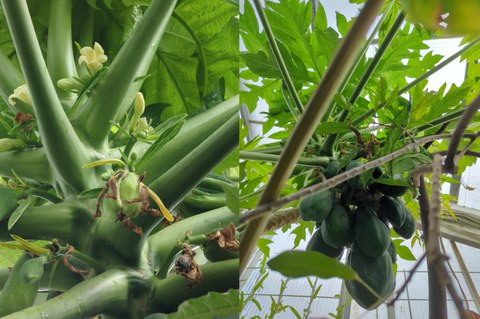Bisherige Pflanzen der Woche - Die Papaya
Die Papaya - Carica papaya L.

Blüten und Früchte der Carica papaya L.
Sommerzeit ist Melonenzeit! Zucker- und Wassermelonen sind wie Gurke und Zucchini flachwüchsige Kürbisgewächse (Cucurbitaceae), die unsere Küche bereichern. Doch was ist ein Melonenbaum? Besser bekannt als Papaya (Carica papaya), findet man diese tropische Nutzpflanze an ganz anderer Stelle des botanischen Stammbaums, in der Nähe der Kreuzblütler, Kaperngewächse und Kapuzinerkressen (Ordnung Brassicales). Den deutschen Namen verdankt das bis zu 10 m hohe, meist unverzweigte Gewächs mit kahlem Stamm und dichtem Blattschopf an der Spitze also lediglich seinen großen, orangegelben, ovalen bis birnenförmigen Früchten, die an Melonen erinnern. Im Botanischen Garten wächst die Papaya im hinteren Teil des Regenwaldhauses II.
Die ursprünglich aus Mittelamerika stammende Pflanze wird heute weltweit in den Tropen und Subtropen angebaut. Ihr Fruchtfleisch, das viele schwarze Samen umschließt, ist reich an Vitamin C, Vitamin A, und Kalium. Man isst es überwiegend roh als Obst.
Alle oberirdischen Pflanzenteile enthalten als Fraßschutz weißen Milchsaft (Latex). Durch Anritzen unreifer Früchte gewinnt man daraus das eiweißspaltende, verdauungsfördernde Enzym Papain. Es dient in der Lebensmittelindustrie u. a. als Fleischzartmacher. Die traditionelle Medizin verwendet den Milchsaft zur Heilung von Wunden, Verbrennungen und Entzündungen, die Kosmetikindustrie setzt Papain in Hautpflegeprodukten ein.
Der Melonenbaum kann ein enormes Fruchtgewicht tragen, obwohl sein Spross nicht aus Holz besteht. Dies weckte die Neugier am Lehrstuhl für Botanik der TU Dresden. Wie erklärt sich bei weniger als 10 % Faseranteil eine solche Stabilität? Die Erforschung des Stützsystems ergab drei Komponenten: vernetzte Bastfasern (Phloem), die äußere Zugkräfte aufnehmen, verholzte Zellen der weiter innen liegenden Wasserleitungsbahnen (Xylem), die Druck- und Scherkräften Widerstand leisten, sowie den Innendruck (Turgor) der lebenden Parenchymzellen, die im Gewebe vorherrschen (Kempe et al. 2013). Biomechanische Untersuchungen zeigten, dass der Spross im Vergleich zu Holz unter experimenteller Krafteinwirkung eine deutlich geringere Biegesteifigkeit aufweist. Die ressourcenschonende Stammanatomie ermöglicht es der Papaya, sehr schnell zu wachsen. Bei der Besiedelung von Lücken in Regen- und Hartholzwäldern kann dies ein wichtiger Konkurrenzvorteil sein.
Kempe et al. (2013): How to become a tree without wood - biomechanical analysis of the stem of Carica papaya L. Plant Biol 16 (1): 264-271 https://doi.org/10.1111/plb.12035
(KW 29/25)
Etwa 10.000 Pflanzenarten wachsen im Botanischen Garten der TU Dresden. Auf dieser Seite stellen wir Ihnen regelmäßig ein Beispiel aus dieser Vielfalt näher vor. Die Besonderheiten unserer wissenschaftlichen Pflanzensammlung zeigen sich auf vielerlei Art und Weise: in erstaunlichen Anpassungen, wunderlichen Namen, einer interessanten Verwendung oder auch in einer außergewöhnlichen Blütenpracht.
Die bisherigen Beiträge zur Pflanze der Woche können Sie im Archiv einsehen.
